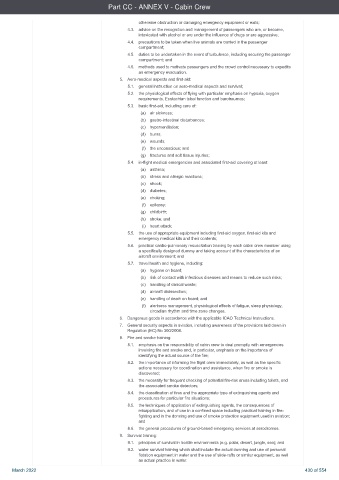Page 430 - UK AirCrew Regulations (Consolidated) March 2022
P. 430
Part CC - ANNEX V - Cabin Crew
otherwise obstruction or damaging emergency equipment or exits;
4.3. advice on the recognition and management of passengers who are, or become,
intoxicated with alcohol or are under the influence of drugs or are aggressive;
4.4. precautions to be taken when live animals are carried in the passenger
compartment;
4.5. duties to be undertaken in the event of turbulence, including securing the passenger
compartment; and
4.6. methods used to motivate passengers and the crowd control necessary to expedite
an emergency evacuation.
5. Aero-medical aspects and first-aid:
5.1. general instruction on aero-medical aspects and survival;
5.2. the physiological effects of flying with particular emphasis on hypoxia, oxygen
requirements, Eustachian tubal function and barotraumas;
5.3. basic first-aid, including care of:
(a) air sickness;
(b) gastro-intestinal disturbances;
(c) hyperventilation;
(d) burns;
(e) wounds;
(f) the unconscious; and
(g) fractures and soft tissue injuries;
5.4. in-flight medical emergencies and associated first-aid covering at least:
(a) asthma;
(b) stress and allergic reactions;
(c) shock;
(d) diabetes;
(e) choking;
(f) epilepsy;
(g) childbirth;
(h) stroke; and
(i) heart attack;
5.5. the use of appropriate equipment including first-aid oxygen, first-aid kits and
emergency medical kits and their contents;
5.6. practical cardio-pulmonary resuscitation training by each cabin crew member using
a specifically designed dummy and taking account of the characteristics of an
aircraft environment; and
5.7. travel health and hygiene, including:
(a) hygiene on board;
(b) risk of contact with infectious diseases and means to reduce such risks;
(c) handling of clinical waste;
(d) aircraft disinsection;
(e) handling of death on board; and
(f) alertness management, physiological effects of fatigue, sleep physiology,
circadian rhythm and time zone changes.
6. Dangerous goods in accordance with the applicable ICAO Technical Instructions.
7. General security aspects in aviation, including awareness of the provisions laid down in
Regulation (EC) No 300/2008.
8. Fire and smoke training:
8.1. emphasis on the responsibility of cabin crew to deal promptly with emergencies
involving fire and smoke and, in particular, emphasis on the importance of
identifying the actual source of the fire;
8.2. the importance of informing the flight crew immediately, as well as the specific
actions necessary for coordination and assistance, when fire or smoke is
discovered;
8.3. the necessity for frequent checking of potential fire-risk areas including toilets, and
the associated smoke detectors;
8.4. the classification of fires and the appropriate type of extinguishing agents and
procedures for particular fire situations;
8.5. the techniques of application of extinguishing agents, the consequences of
misapplication, and of use in a confined space including practical training in fire-
fighting and in the donning and use of smoke protection equipment used in aviation;
and
8.6. the general procedures of ground-based emergency services at aerodromes.
9. Survival training:
9.1. principles of survival in hostile environments (e.g. polar, desert, jungle, sea); and
9.2. water survival training which shall include the actual donning and use of personal
flotation equipment in water and the use of slide-rafts or similar equipment, as well
as actual practice in water.
March 2022 430 of 554

